
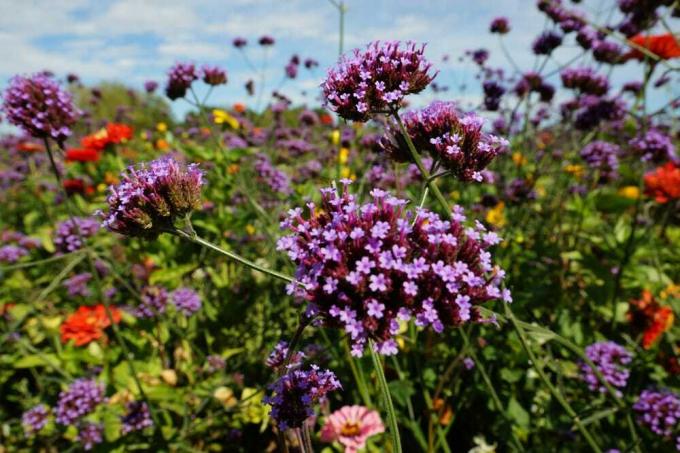
Table of contents
- Patagonian verbena
- Site and soil requirements
- sowing and planting
- Care Instructions
- hibernate
The Patagonian verbena can inspire, as it proved in the 1980s when it was a public favorite at state garden shows. It is difficult to understand why Verbena bonariensis has been so forgotten since then - if it is due to the often invoked "one year old", this is revealed in the article as a "fake". If you love having your garden bursting with blooms without too much effort, then Patagonian is for you Vervain your plant - whose modest requirements in any reasonably suitable location will surprise you become:
Patagonian verbena
- Verbena bonariensis belongs to the verbena family
- The tall plant develops a sea of purple flowers that appear to be floating on the stems
- A spectacular impression when planted in large numbers
- Which you can enjoy from June to October, an "endless" flowering period
- Also very persistent in the vase and as a dried flower
- The South American perennial is a perennial and can survive German winters in many regions with a little protection
- In cold areas it could be difficult to hibernate
- But all you have to do is let a few seeds mature and the verbena will appear reliably next season
- The care is hardly worth mentioning: At the right location you only have to remove the old stems in spring
- In addition to the natural species, the varieties 'Cloud' (larger flowers) and 'Lollipop' (compact dwarfism) are offered
Site and soil requirements
The Patagonian or Argentine vervain bears its origin in the name, so the natural location is under the South American sun. Verbena bonariensis grows as a tall, slender perennial that forms clumps and stretches upright towards the sun. A striking and special summer flower that "makes a statement" in the garden, especially if you plant larger areas with the verbena plant planting: The perennial bloomer develops tall shoots, but very fine ones with little foliage, which of course become even finer and thinner towards the top. On the other hand, the flowers, which are always new throughout the season and only at the extreme end of the shoots are formed, a stronger structure, intense color and a not to be overlooked size between 5 and 10 centimeters.
A contrast that deserves to be highlighted because it creates a rather spectacular effect: the flowers of the Patagonian verbena appear as a horde of blooming balls, floating above delicate, scattered greenery seem. These flowers "float" without the stems needing support, and they float for an unusually long time, from May/June to late autumn; i.e. the entire time in which the garden is used to rest, relax and admire the flowers.

The British Royal Horticultural Society (RHS) finds the Patagonian Vervain also interesting and has exactly the talents of Verbena bonariensis as a garden plant 2002 examined. This also includes a precise description of the characteristics and requirements of the species:
- Names: Botanically Verbena bonariensis, vernacular Patagonian or Argentine vervain
- Synonyms of the botanical name: Verbena bonariensis 'Buenos Aires' (double mobbled, bonariensis means Buenos Aires), Verbena brasiliensis (misnomer)
- Large perennial with erect, branched stems up to 2 m tall
- With sparse, oblong leaves and large branched clusters of small lilac flowers from summer to autumn
- Distribution: South America
- Foliage: Deciduous
- Growth habit: columnar/upright
- Scent: flowers
- Colour: Green leaves and purple flowers from spring to autumn
- Light, Sun: Full sun
- Planting direction: south or west side
- Site environment: The Patagonian verbena can be planted free-standing or protected (by neighboring plants or house walls).
- Soil: Grows in clay soil, loamy soil, chalky soil, sandy soil
- Soil Moisture: Moist but well drained / well drained
- pH value: acidic, neutral, alkaline
- Adult Plant Size: Final height 1.5 to 2.5 meters; final width 0.1 to 0.5 meters, time to reach final height: 2 to 5 years
- Pests: Normally no pest infestation
- Diseases: Normally no diseases
- Recommended use (locations and garden types): flower borders and beds, planting on walls, steppe gardens, gravel and rock gardens, city and courtyard gardens
After classification and extensive testing in one of the "royal gardens", the Patagonian verbena was the RHS Award of Garden Merit, recognizing Patagonian verbena as an outstanding garden plant grades. The RHS sometimes lists very definite claims, but specifies optimal conditions, if not every detail is correct, the Argentine vervain will certainly continue to grow.
If the Patagonian verbena is not planted in an open space, but in community with other plants, the following planting partners have qualified as good neighboring plants:
- Smut Herbs (Phlomis)
- Foxgloves (digitalis)
- Joint flowers (Physostegia)
- Grasses such as proso millet (Panicum, e.g. B. Switchgrass P virgatum)
- High girls eyes like Coreopsis tripteris
- Magnificent Candles (Gaura)
- Purple Coneflower (Echinacea purpurea)
- Roses (tall shrub or bed roses)
Tip:
The Patagonian verbena is planted in groups; the larger the group, the better the effect. You can use a special talent of the verbena: In combination plantings, it can grow outside of the border because it grows semi-transparent and plants growing behind it come into their own leaves.
sowing and planting
By choosing the right location, you have actually done everything necessary to allow a Verbena bonariensis to thrive. Both sowing and planting young plants is unproblematic, which is why the RHS “How to grow” consists of the following sentences limited: seeds can be grown in pots at temperatures between 18 and 21°C (or self-sowing.) from autumn to early spring be left). Plant young plants in moist to dry, well-drained soil in sunny spots and protect with dry mulch in cold regions in winter.
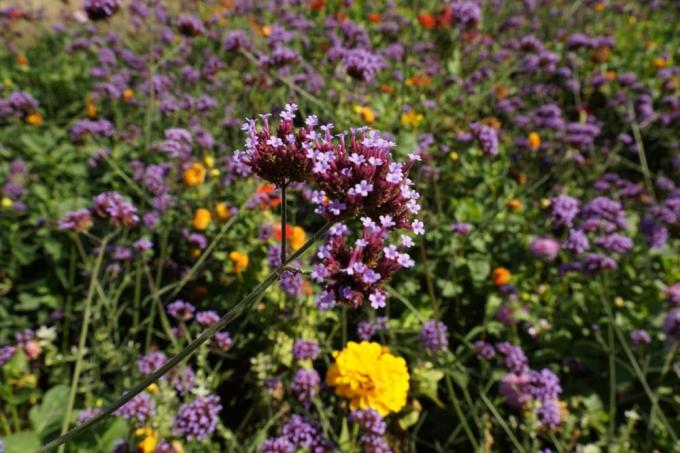
Seeds from the trade can be sown without pre-treatment, even directly outdoors. Then, best in autumn, saves the stratification (cold treatment to break the dormancy) in the refrigerator. Seeds collected from a plant are allowed to sit in the fridge for a few hours or days to stratify before sowing, which otherwise works like this:
- Sowing dates: February-April
- Soak the seeds in lukewarm water overnight
- Germination time: 5-10 days at 21-24 °C, longer in colder soil
- Verbena sown without stratification usually also germinate, but u. u only after weeks
- Scatter light germs loosely and dust lightly with substrate
- Occasionally one reads that v. bonariensis belong to the dark germs; that's not true, how should such fine seeds fight their way to the surface of the earth?
- Only slightly moisten the potting soil, V. bonariensis germinate best in a moderately moist to dry environment
- Although the seed pots can be covered with foil to increase the humidity
- Otherwise, the seed does not have to be watered, waterlogging must be avoided at all stages of germination
- With the appearance of the first real leaves after the cotyledons, the small plants are covered
- Then the seedlings can also be pricked out
- A large number of seedlings do not have to be planted individually, you can simply thin out the existing plants
- When the seedlings are hand-high, they can be trimmed (snip off the tip of the shoot with your thumb and forefinger) so that they branch better
- When the last night frosts are surely over, the young plants can move to the open air bed
Flowers will soon appear in abundance, which will not only be a very attractive eye-catcher, but so many bees and butterflies attract that the Patagonian Verbena also received a "Royal Award" as a "Perfect Pollinatinor Plant" (perfect plant for pollinators) received.
Tip:
The Patagonian Verbena is suitable for pot planting, but you need a fairly large pot for the normal Verbena bonariensis. Alternative: plant the short Verbena bonariensis variety 'Lollipop', which grows to a height of around 50 cm can even adorn balcony boxes (caution: If 'Lollipop' is allowed to spread seeds, they will grow into tall ones again verbs).
Care Instructions
The "Award of Garden Merit" certifies that the award-winning ornamental plant has the following qualities:
- The species/variety is of outstanding garden value when used normally and cultivated under appropriate conditions
- The type/variety is available (for hobby gardeners, in reasonable quantities at reasonable prices and without unreasonable effort)
- The species/variety is of good constitution and generally healthy
- The species/variety is stable in shape and color and the individual plants usually correspond reliably to the sales description
- The species/cultivar is disease and pest resistant, and not particularly susceptible to any particular disease or parasite.
With the Patagonian verbena as the bearer of this award, the British “how to care” is logically limited in a single set: Pruning: Prune in spring when new shoots emerge from the base develop; "Behead" in the fall when no sowing is desired and the seeds are not to be collected.
As off-island gardeners may not have a few centuries of gardening experience (as most English people arguably do) here are a few additional notes:
- Cultivate as dry and airy as possible overall, this promotes early flowering induction
- Usually no additional watering necessary
- In the case of prolonged heat, the V. bonariensis extra water
- Verbena in buckets are watered when the top layer of soil has dried
- The nutrients in normal soil and also in sandy and stony poor soil are sufficient for the garden verbena
- Fertilize in the bucket, about every 2 weeks during the growing season
- Don't let plants grow too close together. Cut out stems inside, but with feeling, the shoots support each other
- Outside shoots could be "flattened" by wind and rain if you cut away supporting partners
- They are also allowed to stay because the plant grows airy enough outside anyway to make fungal attack unlikely
- Regularly cutting away faded flowers promotes the creation of new flowers
- Don't forget to let the last flowers mature on the plant if you want the plant to self-seed
Tip:
The long flower stalks of Patagonian verbena appear delicate but are strong and square and even lignify - otherwise they could not grow so high without support, nor could the large umbels of flowers carry. With this stalk, V qualifies. bonariensis makes an excellent cut flower, said to last up to 2 weeks in a vase, and as a long lasting dried flower. For the vase, cut flowers that are just or not quite open, verbena to dry harvested at any desired stage of maturity and hung upside down in a warm and airy place.
hibernate
With the Award of Garten Merit, the “RHS hardiness rating” belongs to the characteristic “with normal use and correct treatment”. Patagonian Vervain is classified as H4 Hardiness: Across most of the UK with average freezing temperatures between -5 and -10°C frost hardy. In the "rest of the world" Verbena bonariensis is planted in USDA International Hardiness Zones 7 through 11 classified, i.e. at average minimum winter temperatures of +10 °C to -17.8 °C survive.

In parts of Germany it is getting colder than in England, our country stretches across USDA hardiness zones 8 to 6. If the international classification is to be believed, in residential areas with USDA hardiness zone 6 (−17.8 °C to −23.3 °C) overwintering of the Patagonian verbena will be tight; if the British are to be believed, overwintering is a problem everywhere in Germany. These facts explain why the Patagonian Verbena is described alternately as perennial and annual, when in fact it is a perennial. But it is also certain that winter hardiness and German winter moisture are not the strengths of the Patagonian Verbena.
Since all the winter hardiness zone information just mentioned only refers to average temperatures, it can also give mild German areas difficulties with overwintering, if the winter once a few extra degrees below zero developed. If you want to safely overwinter a specific rare-color Argentine verbena, you should therefore dig it up before the permafrost and either in a pot or like dahlias with bare roots hibernate.
Otherwise, you can risk it in mild locations - if the verbena does not overwinter creates, it usually ensures its continued existence in the next season by self-sowing on the given one Location. The following preparations increase the overwintering chances of the old plants:
- Let the plant go into winter with full foliage and whole stems
- Apply dry mulch of leaves, brushwood, straw around the roots
- Which remains until after the last late frosts
- Shortly before sprouting in spring, completely cut back last year's foliage
- Patagonian vervain in the bucket hibernates in a cool, but frost-free and bright room and occasionally gets little water in winter
- Planters are only allowed to go outside again when there is no longer any fear of late frost (after the Ice Saints in mid-May).
 garden editorial
garden editorial I write about everything that interests me in my garden.
Find out more about perennial lexicon

Lenten rose, Helleborus orientalis: 13 tips for care
The spring rose is one of the few plants that also blooms in winter. In order for the plant to bear its colorful flowers, however, certain requirements regarding location and care must be met.
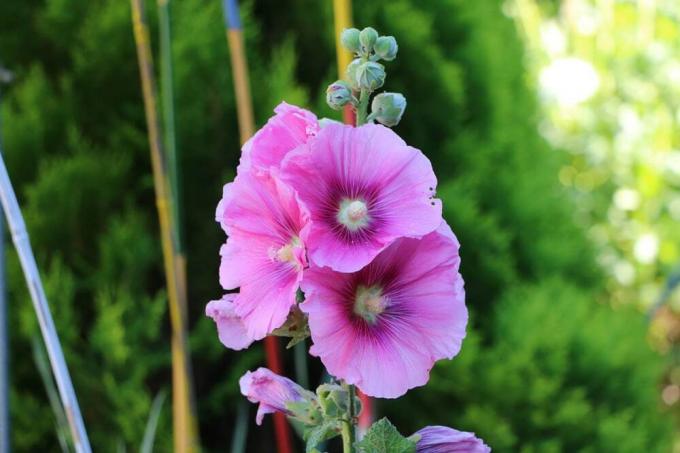
13 hardy perennials for sunny locations
Hardy perennials have a particularly long lifespan and allow sunny locations to bloom beautifully. At the beginning of each season, the perennial plants thrive anew and enchant the garden with a colorful world of flowers. Due to the large number of varieties, you have many design options.

Tree peony, Paeonia suffruticosa: Care from A - Z
With its large, eye-catching and colorful flowers, it is one of the noblest representatives of the peonies, the tree peony. Its natural home is China, which is why it is often referred to as the imperial flower. It presents its beautiful flowers between April and June.

Fat man: Care from A-Z | Planting distance and propagation
The shady areas under trees are neglected in many gardens, because only a few plants feel comfortable here. One of these few plants is the fat man (bot. Pachysander terminalis).
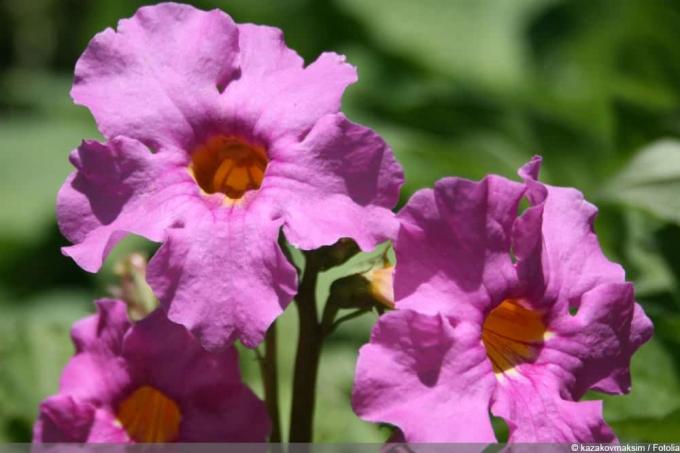
Flowering Fern: 14 Annual and Hardy Species | Care Instructions
A green fern with its beautifully designed fronds is a feast for the eyes in itself. It doesn't have to bloom to inspire. If flowers do appear, a garden gloxinia is actually at work. This flower is often incorrectly referred to as a blooming fern.
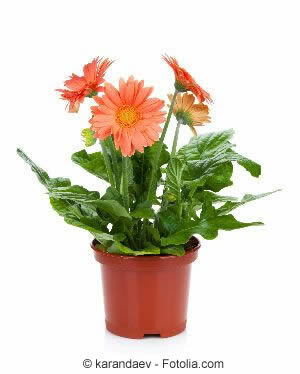
Pot gerbera - instructions for caring for gerberas in pots
The pot gerbera is a lot of fun, but requires a lot of care. It needs to be watered daily and fertilized regularly. A lot of light is a must and yet it must not be exposed to excessive heat. But if you treat her properly, she will thank you with her beautiful flowers.
